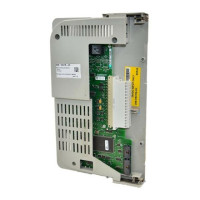Faults 43
Faults Faults are conditions occurring within and/or outside of the drive. These conditions
are (by default) considered to be important enough that drive operation is
discontinued. Faults are annunciated via the HIM, communications and/or digital
outputs.
Once a fault occurs, it is latched, requiring a fault reset action. If the condition that
caused fault still exists when the fault is reset, the drive will fault again and the fault
will be latched again.
When a Fault Occurs
1. The drive is set as faulted, causing the drive output to be immediately disabled
and a “coast to stop” sequence to occur
2. The fault code is entered into the first buffer of the fault queue (see “Fault
Queue” below for rules).
3. Additional data on the status of the drive at the time that the fault occurred is
recorded. Note that there is only a single copy of this information which is
always related to the most recent fault queue entry [Fault 1 Code], parameter
243. When another fault occurs, this data is overwritten with the new fault data.
The following data/conditions are captured and latched into non-volatile drive
memory:
– [Status 1 @ Fault] - drive condition at the time of the fault.
– [Status 2 @ Fault] - drive condition at the time of the fault.
– [Alarm 1 @ Fault], - alarm condition at the time of the fault.
– [Alarm 2 @ Fault] - alarm conditions at the time of the fault.
– [Fault Amps] - output amps at time of fault.
– [Fault Bus Volts] - DC Bus volts at time of fault.
– [Fault Frequency] or [Fault Speed] - drive output frequency (or speed) at
time of fault.
Fault Queue
Faults are also logged into a fault queue such that a history of the most recent fault
events is retained. Each recorded event includes a fault code (with associated text)
and a fault time of occurrence.
A fault queue will record the occurrence of each fault event that occurs while no
other fault is latched. A new fault event will not be logged to the fault queue if a
previous fault has already occurred, but has not yet been reset. Only faults that
actually trip the drive will be logged. A fault that occurs while the drive is already
faulted will be not be logged.
The fault queue is a first-in, first-out (FIFO) queue. Fault queue entry #1 will
always be the most-recent entry (newest). As new faults are logged, existing entries
will be shifted up by one. If the queue is full when a fault occurs, the oldest entry
will be discarded.
The fault queue will be saved in nonvolatile storage at power loss, thus retaining its
contents through a power off-on cycle.
70EC
700VC
700H
✔✔

